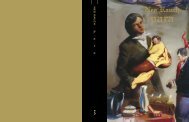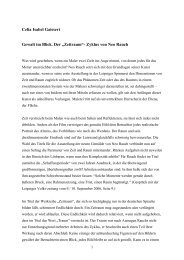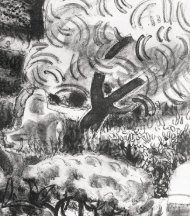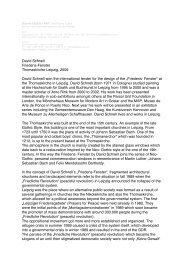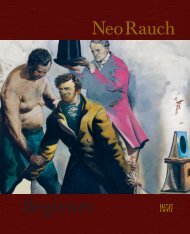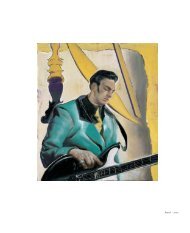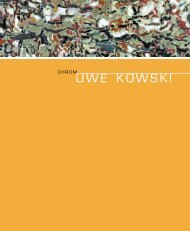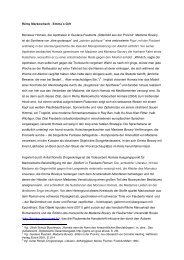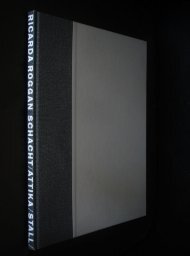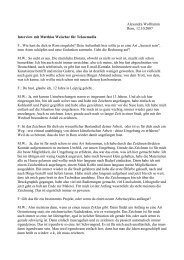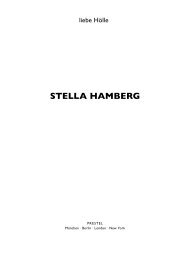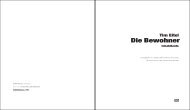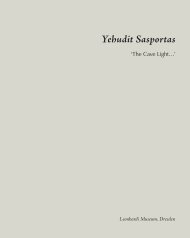Nina Fischer & Maroan el Sani Blind Spots
Nina Fischer & Maroan el Sani Blind Spots
Nina Fischer & Maroan el Sani Blind Spots
Sie wollen auch ein ePaper? Erhöhen Sie die Reichweite Ihrer Titel.
YUMPU macht aus Druck-PDFs automatisch weboptimierte ePaper, die Google liebt.
8<br />
9<br />
Gabri<strong>el</strong>e Knapstein<br />
‘Memories of the Future’<br />
On Works by <strong>Nina</strong> <strong>Fischer</strong> and <strong>Maroan</strong> <strong>el</strong> <strong>Sani</strong><br />
‘The empty space is the point of departure.’<br />
Several months after the fall of the<br />
Berlin Wall, in early summer 1990, <strong>Nina</strong><br />
<strong>Fischer</strong> was walking through the streets<br />
of East Berlin looking for a workspace:<br />
‘I am searching for an empty space. /<br />
This search leads me to the eastern part<br />
of the city, a place of which I have no<br />
memories yet, / also empty space because<br />
for me still unexplored, / open to<br />
the new.’ 1 She finds what she’s looking<br />
for on Tucholskystraße in Berlin-Mitte: ‘In<br />
a courtyard, between metre-high rubble,<br />
junk, / I meet people who show me the<br />
way in. / Through a broken window I enter<br />
a large room, / dark, a strange odour, a<br />
stove, extending from the floor to the ceiling,<br />
takes up half the space, / through<br />
the door you enter / a nearly square room,<br />
with barred windows, / then, over cartons<br />
and along a corridor, / it stinks / two<br />
more rooms, with no light, past remnants<br />
/ or a time as a store / into the salesroom<br />
/ white-tiled walls, rows of hooks everywhere,<br />
shop window with sh<strong>el</strong>ves, swing<br />
door, black-and-white / tile pattern – a<br />
former butcher’s.’ 2 Together with friends,<br />
including <strong>Maroan</strong> <strong>el</strong> <strong>Sani</strong>, she occupies<br />
the rooms, to work there as an artist, to<br />
organise events there and to run an unofficial<br />
bar. She begins by emptying the<br />
rooms, for only empty space, she reasons,<br />
offers unexpected possibilities. However,<br />
she finds: ‘There is no such thing as<br />
empty space, / every existing room is a<br />
place, / because even beyond its simple<br />
dimensions it is found in a certain place,<br />
serves a certain purpose, or did or will, /<br />
space is never characterless, never truly<br />
bare, vacant.’ 3 <strong>Nina</strong> <strong>Fischer</strong> and <strong>Maroan</strong><br />
<strong>el</strong> <strong>Sani</strong> began to research the history of<br />
the place and its former users, which led<br />
to the Super-8 film Der leere Raum: Die<br />
Suche nach dem Fleischer B. Friedrich<br />
(Empty Space: The Search for the Butcher<br />
B. Friedrich, 1991). They researched the<br />
history of the neighbourhood, interviewed<br />
neighbours and Friedrich the butcher<br />
about their memories. To mark the transition<br />
of the spaces from their past use<br />
to their future use, <strong>Nina</strong> <strong>Fischer</strong> wrapped<br />
the interior walls of the largest room –<br />
the former smokehouse – with transparent<br />
plastic sheeting; in doing so she created<br />
a negative form of the space and thus created<br />
a vacuum, a void in the middle of the<br />
former butcher’s: ‘It is a space between<br />
times; it has lost its old purpose; its new<br />
one is not yet known.’ 4<br />
Like many other young artists, curators,<br />
gallery owners and organisers, <strong>Nina</strong><br />
<strong>Fischer</strong>, <strong>Maroan</strong> <strong>el</strong> <strong>Sani</strong> and their peers<br />
on Tucholskystraße were fascinated by<br />
the abandoned buildings and their decline,<br />
typical in this former Jewish quarter<br />
in Spandauer Vorstadt. Over the course<br />
of the early 1990s, more and more exhibition<br />
spaces and clubs moved to the<br />
neighbourhood around Tucholskystraße,<br />
Augustraße, Linienstraße and Sophienstraße.<br />
Benefiting from unsettled questions<br />
of ownership, vacant buildings were<br />
squatted and invigorated with temporary<br />
art projects and bars; the former butcher<br />
on Tucholskystraße was one of the very<br />
first sites in this district put to use for contemporary<br />
art. It was followed by a former<br />
liqueur factory and an old margarine<br />
factory on Auguststraße – in the 1990s<br />
the latter became the home of the Kunst-<br />
Werke, now the KW Institute for Contemporary<br />
Art – as w<strong>el</strong>l as vacant shops,<br />
workplaces and flats in which galleries<br />
were opened. Recently, the 4th Berlin<br />
Biennale again evoked this earlier occu-<br />
pation of the neighbourhood by contemporary<br />
art with exhibitions in several<br />
buildings along Auguststraße; characteristically<br />
however, there was no critical<br />
reflection on the changes in ownership<br />
or the gentrification process in Berlin’s<br />
Mitte district. 5<br />
<strong>Nina</strong> <strong>Fischer</strong> and <strong>Maroan</strong> <strong>el</strong> <strong>Sani</strong>, both<br />
of whom moved to Berlin in the late 1980s<br />
for their studies, began their artistic collaboration<br />
in the early 1990s at a time<br />
of upheaval in which the situation for contemporary<br />
art in Berlin was changing at<br />
a tremendous rate. Above all, the numerous<br />
alternative and usually temporary<br />
initiatives in the centre of the city, in which<br />
artists moved between art, club culture<br />
and new technologies, constitute the fi<strong>el</strong>d<br />
of their artistic research. Sites or projects<br />
such as the allgirls gallery, Mutzek, Botschaft,<br />
dogfilm and Internationale Stadt,<br />
and clubs such as WMF, Friseur, Elektro<br />
and Panasonic were important meeting<br />
points for them. 6 Their first joint exhibition<br />
in 1993 in one of the then up-and-coming<br />
new galleries in Berlin-Mitte, Galerie<br />
EIGEN + ART on Auguststraße, was titled<br />
‘Neue Produkte aus der Chaosforschung’<br />
(New Products from Chaos Research).<br />
‘Nothing is impossible.’<br />
Their collaborative work initially focused<br />
on phenomena on the margins<br />
of science and later on the sphere of the<br />
paranormal. Chaos theory and its study<br />
of the s<strong>el</strong>f-organisation of complex systems,<br />
which has been very popular since<br />
the late 1980s, led to a realisation that<br />
for all the calculability and control of such<br />
complex systems, it was always necessary<br />
to figure in random factors which<br />
could lead to unpredictable results. <strong>Nina</strong><br />
<strong>Fischer</strong> and <strong>Maroan</strong> <strong>el</strong> <strong>Sani</strong> referred to<br />
one of the frequently cited examples from<br />
such research in their exhibition: ‘Even the<br />
beating of a butterfly’s wings can, at least<br />
theoretically, become the crucial trigger<br />
for a tornado two weeks later.’ 7 Hanging<br />
from the ceiling of the gallery was a<br />
diorama in which a mounted butterfly was<br />
seen among a variety of plants and from<br />
a loudspeaker came the phrase: ‘Nothing<br />
is impossible’. The slogan comes from<br />
the world of product advertising; it can<br />
be r<strong>el</strong>ated to advertising videos, of the sort<br />
usually seen in department stores, shown<br />
on monitors on cheap metal sh<strong>el</strong>ving. The<br />
phrase caricatures the promise promoted<br />
in such videos that the everyday chaos of<br />
dust particles can be brought under control<br />
with the latest dust mop. The upshot<br />
of chaos theory that the artists derived<br />
from observing the madness of everyday<br />
life: ‘Everything can happen, because<br />
so much order can be whisked in with<br />
the dust-trapping universal mop.’ 8 Unspectacular<br />
coincidences, they observe,<br />
can change the course of things at any<br />
time and bring about a turn in a story.<br />
By means of computer technology,<br />
chaos researchers illustrate on micro and<br />
macro scales nonlinear structures that<br />
cannot be seen by the naked eye. One<br />
example of such computer-generated images<br />
was also in the exhibition: on a tiny<br />
monitor, forced into a bottle like a miniature<br />
ship, appear beguilingly beautiful<br />
images of order in chaos created by fractal<br />
geometry. In their exhibition, the art-<br />
ists reject in a humorous way any blind<br />
faith in science.<br />
In addition to illustrating scientific theories,<br />
<strong>Nina</strong> <strong>Fischer</strong> and <strong>Maroan</strong> <strong>el</strong> <strong>Sani</strong> are<br />
also interested in revealing so-called paranormal<br />
phenomena. Hence in their series<br />
of photographs titled Aurakonserven und<br />
die Sehnsucht nach der Sichtbarmachung<br />
des Unsichtbaren (Tinned Aura and<br />
the Desire to Make the Invisible Visible,<br />
1994–2005), they made use of the highfrequency<br />
photography dev<strong>el</strong>oped by<br />
the Ukrainian researchers Semyon and<br />
Valentina Kirlian in the late 1930s to make<br />
<strong>el</strong>ectromagnetic fi<strong>el</strong>ds visible. The apparitions<br />
of light which can be recorded by<br />
Kirlian photography, which have also been<br />
interpreted as ‘auras’, were recorded by<br />
<strong>Fischer</strong> and <strong>el</strong> <strong>Sani</strong> in rooms that had long<br />
since been vacated by their residents but<br />
had been preserved and maintained in<br />
their former state. The colourful forms that<br />
emerge from a dark background seem<br />
to capture on film the atmosphere of the<br />
place in question, the ‘residual radiation’,<br />
the auras of the people who have disappeared.<br />
These photographs were juxtaposed<br />
with traditional photographs of<br />
the interiors and exteriors of rooms once<br />
used by such prominent figures as Albert<br />
Einstein and Bertolt Brecht. Following the<br />
tradition of ‘spirit and thought’ photo-<br />
graphy from the turn of 19th to the 20th<br />
century, the artists traced invisible energy<br />
fi<strong>el</strong>ds that, as early modern artists and<br />
scientists interested in esoteric and occult<br />
ideas were convinced, could be depic-<br />
ted and made visible particularly w<strong>el</strong>l by<br />
means of photography. 9<br />
With unprejudiced gazes, curious and<br />
amused at the same time, <strong>Nina</strong> <strong>Fischer</strong><br />
and <strong>Maroan</strong> <strong>el</strong> <strong>Sani</strong> question through<br />
their aura research and internet project<br />
Talk with Tomorrow (1994) the current<br />
state of the debate over paranormal phenomena.<br />
To that end, they did not hesi-<br />
tate to visit the Institute for Frontier Areas<br />
of Psychology and Mental Health in<br />
Freiburg. Their decision in 1995 to always<br />
appear as a duo in future projects was<br />
reinforced by a fictional autobiography:<br />
in their video Be Supernatural (1995),<br />
<strong>Nina</strong> <strong>Fischer</strong> and <strong>Maroan</strong> <strong>el</strong> <strong>Sani</strong> are introduced<br />
as children with supernatural<br />
powers who later meet at the Institute of



